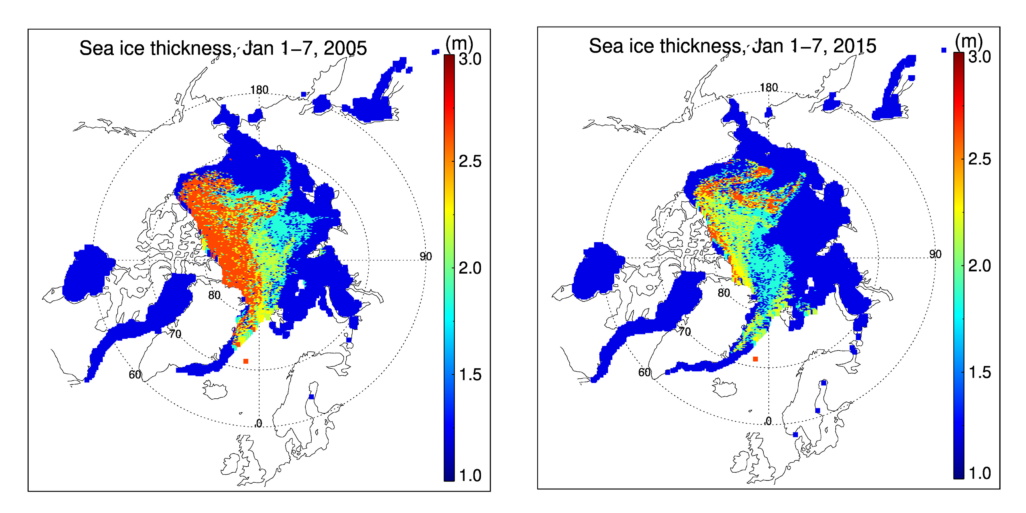Arctic sea ice trends
The decline in sea ice in the Arctic presents a stark picture of a changing Earth climate. And while the area covered by sea ice remains a valuable measurement, scientists are beginning to investigate other parameters that can also serve as key indicators.
“Researchers have realized that maybe sea ice volume is a more sensitive parameter that we need to look at,” says Yinghui Liu, a scientist with the National Oceanic and Atmospheric Administration’s Advanced Satellite Products Branch stationed at the University of Wisconsin–Madison’s Cooperative Institute for Meteorological Satellite Studies.
In early 2020 Liu and several of his colleagues published a paper in the journal The Cryosphere detailing new sea ice volume research. Liu, working with Jeff Key of NOAA ASPB, Xuanji Wang of CIMSS, and Mark Tschudi of the University of Colorado in Boulder, Colorado, studied the relationship between sea ice age and thickness and how that information can be used to estimate sea ice volume as another way to study changes in Arctic sea ice over time.
“Sea ice change is one of the most active research areas in recent years,” says Liu. “Based on the satellite images and the long-term monitoring, there has been a lot of research on the sea ice extent trends in the Arctic … you can clearly see shrinking of the sea ice cover in the Arctic in the summertime.”
However, sea ice research continues to evolve as scientists pursue other approaches to studying trends in the Arctic, including changes in sea ice volume.
Previous work on sea ice volume tended to use observations over relatively short time periods. To be useful for climate studies, scientists need several decades of observations — typically on the order of 30-plus years — and while there have been studies of sea ice volume on these larger time scales, they also tend to have significant uncertainties, according to Liu. The key is developing a more accurate approach to estimating sea ice thickness over long periods of time.
Liu also notes that prior research had observed and used a linear relationship between sea ice age and thickness, but only in the month of March over several years. With this new study, Liu and his colleagues explored the relationship between sea ice age and thickness and then applied this knowledge to determine thickness and volume throughout the entire year as the amount of ice fluctuates.

“Our work tries to extend the relationship in one month to relationships in every month of the year, from 1984 to the present,” says Liu.
In order to develop and train their algorithm, they used a number of different datasets in addition to ice age, including upward-looking sonar observations from submarines from 1984-2000 to estimate sea ice thickness and then later satellite altimeter measurements of sea ice thickness and volume from 2003-2008. That algorithm then needs to be evaluated and validated using different datasets to ensure its accuracy independently. For their comparisons, Liu and his colleagues used sea ice thickness and volume products from the Pan-Arctic Ice-Ocean Modeling and Assimilation System model for the period 1984-2018, as well as sea ice thickness and volume products from CryoSat-2 altimeter data from 2011-2018.
“Our products agree well with the evaluation and validation dataset. That gives us confidence in our algorithm,” says Liu.
Although sea ice cover remains the most easily visible reminder of Arctic sea ice changes, Liu notes that their research showed that changes in sea ice thickness often have a far greater impact on sea ice volume, particularly during the winter in the Arctic.

“Changes in the thickness contribute 80 percent or more to the decreasing sea ice volume trend from 1984-2018, November to May,” says Liu.
With sea ice extent at its maximum during these Arctic winter months, changes in sea ice volume are easily attributable to changes in thickness. However, during August and September, when the sea ice cover is at its minimum, the sea ice thickness still contributes more to the changing volume trend — contributing approximately 50 percent. Throughout the entire year changes in sea ice extent contribute approximately 30 percent towards the changes in sea ice volume. Liu states that more research is needed to understand why sea ice extent does not have a greater impact on sea ice volume during August and September, when sea ice cover is at its minimum.
As Liu and his colleagues continue to study the changing Arctic sea ice, they plan to take a closer look at their use of a linear relationship between sea ice age and sea ice thickness. As Liu concedes, “it’s more likely not linear.” Similarly, their current approach assumes that sea ice melt and sea ice growth are both linear during the year, while both are more likely non-linear as well. Liu would like to address and refine these assumptions in future research efforts and suggests that engaging the broader sea ice community would prove beneficial.
“Sea ice thickness and sea ice volume retrievals from satellites are very important parameters. We still have large uncertainties. As individuals we need to work on decreasing those uncertainties. And probably we will need to work with the whole community to come up with better products by combining all the sea ice thickness and volume products by knowing each product’s limitations and strengths,” says Liu.
This work is supported by the NOAA National Centers for Environmental Information Climate Data Records Program and the Joint Polar Satellite System Program Office.

